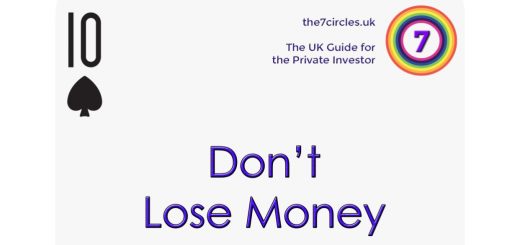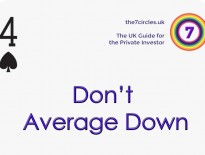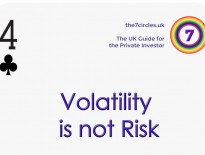4♦ – Cut Your Losses
Cut your losses, and let your winners run
This post is part of the MoneyDeck series, a pack of 52 playing cards that describe 52 “golden rules” for Private Investors in the UK.
Today we’re going to talk about the oldest rule in the book: cut your losses, and let your winners run.
- It sounds simple enough, but most people find it a difficult rule to implement in practice.
Rule number one – don’t lose money. Rule number two – never forget rule number one. – Warren Buffett
Even being right three or four times out of ten should yield a person a fortune if he has the sense to cut his losses quickly. – Bernard Baruch
Cut out your weeds and water your flowers. – Warren Buffett
If you can’t take a small loss, sooner or later you will take the mother of all losses. – Ed Seykota
For the purposes of today’s post, we’re going to view an investor and a trader as roughly the same thing, but over different holding periods.
- Stock charts are fractal – you can’t tell whether you’re looking at a daily chart or a ten-year chart without the labels
- Which means that many of the same rules apply to both
Being a successful trader or investor isn’t a matter of picking a succession of winners.
- Nobody’s batting average is 100%
- If you can beat 50% you are doing well
- Certainly well enough to be successful over the long-run
The way you make 50% winners a profitable strategy is by winning more on your winners than you lose on your losers.
- Which is why you need to cut your losses and let your winners run.
You need to get your money out of the dogs and into the stuff that is going up.
- So think about what you have to gain by changing things.
Here’s how it works.
- You decide how much you can afford to lose on a single trade.
- Most people go for somewhere around 2% of their total portfolio size.
- This means that you can lose 50 trades in a row without going bust.
- You set your stop-loss (or your mental sell price) at the place where you would be down 2%.
The other side of the coin is that you need be convinced that the upside is, at least, double your 2% maximum loss.
- And for short-term trading (for our purposes, between two days and six months), you need to check that the daily volatility (ATR) of the instrument you are trading is smaller than your stop loss.
- That way you have a fighting chance of not getting stopped out on the first day.
You’re going to get a lot of your stops hit.
- If you’re a short-term trader, maybe 50%
If you can’t handle that, you probably shouldn’t be a short-term trader.
- And if you can’t handle losses at all, you should probably stick to passive investing.
This stuff isn’t for everybody. It’s for those who can deal with the human factor, with the emotional side of investing.
Let’s go through a practical example, using a short-term trader.
- He has a £10K portfolio, and his maximum loss per trade is 2% (£200)
- This £200 is known as R, the money at risk
- He never sells a winner until he’s made at least 2R (as you’ll see below, I recommend holding on for more)
- He makes 20 trades, of which 4 are winners and 6 are losers
- The 6 losers lose a total of 6R
- The 4 winners make 8R, so he’s 4R ahead (before any trading costs)
Even with a losing sequence of trades, you can make money if you have discipline.
The reason people hold on to losers is because of psychological biases.
The biggest of these is that people don’t like to admit that they have made a mistake – especially a mistake that has cost them money.
- They didn’t buy the wrong stock, they bought it at the wrong time.
- If it was good value at 100p, it’s a bargain at 70p.
- This kind of thinking leads people to buy more of a stock that has fallen in price.
- This is “averaging down” – don’t do this.
- “A loss is not a loss until you sell” – not true.
What they really mean is “you haven’t failed until you admit to yourself that you’ve failed”.
The fear of failure makes you try fewer things, and it makes those few attempts very important to you.
- This is the opposite of the approach you want to cultivate in investment
- You need to do the right things again and again, and not worry too much about whether any individual attempt is successful
In any case, everybody fails. It’s part of being human.
The second basic bias is the endowment effect.
- People like a stock because it is theirs.
- This also means that they tend to focus on good news about the stock, and ignore the bad news (confirmation bias).
People also tend to transfer the idea that the stock market always recovers to make new highs (any long-term chart will show wobbly progress from the bottom left corner to the top right) over to individual stocks
- They live in hope that their investment will recover its former glory – but hope is not a strategy.
- The trouble is, the ever-increasing index is made up of winners.
- Those stocks that didn’t cut the mustard went bust or have been dropped (or in the case of an “All-Stocks” index, their market capitalisation becomes so small that they barely move the needle on the index).
- This is called survivorship bias.
Another problem is neglect.
- When markets are booming, and their portfolios are hitting new highs, people are very interested in their stocks.
- When markets are bad and they are losing money, people prefer to avoid the truth, and ignore their stocks.
- So just at the time when their attention would be valuable, people don’t give it.
The only time you might not want to sell a losing position is when your stocks are dragged down by a market crash, like 2008.
- Here it might be true that the investment story is still in place, and you might not want to sell.
- You might even want to buy more.
- In which case, mental stops might be the best approach for you.
The other part of successful trading and investment is hanging on to your winners, and this is just as difficult.
- You need your winners to win you more than your losers lose.
But winning is exciting, and banking a profit feels like an achievement.
- The race is run, and you came first.
Your friends – especially the ones who are just a little more experienced that you – will tell you that “nobody ever went broke banking a profit.”
- But they’re wrong.
If your maximum loss is 2%, you can’t sell when you’ve made 2%.
- You need to wait for 4% and ideally 6% or 10%.
The bigger your winners, the more losers you can afford to have.
- So don’t sell too early.
- You really want to make sure that the trend has reached the end, and the price has started to move against you.
The way to implement the “cut losers, run winners” strategy is to take emotion out of things.
- You need a plan – either an investment strategy for your portfolio or a trading plan for your individual trades.
- You need a rule for buying (what’s the setup, what’s the objective)?
- This can be based on fundamentals or technicals, depending on your portfolio.
- And you need a rule for selling.
Actually, you need two selling rules:
- One for getting out of losers.
- For technical trading, this will be a mechanical trailing stop-loss, but even for fundamental portfolios, a mental 20% stop loss is a good idea.
- And a second rule for getting out of winners – after you have let them run of course.
- This might also be the trailing stop loss for technical traders, but for fundamental investors, it might be a PE valuation target or a profit warning.
- It might also be a periodic review which asks the question “Would I buy this stock now?”
So remember: Cut your losses, and let your winners run.
Until next time.


















